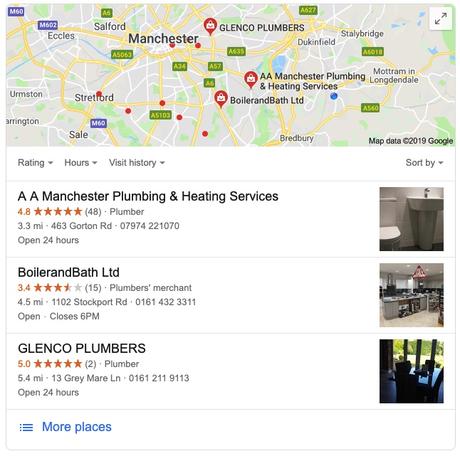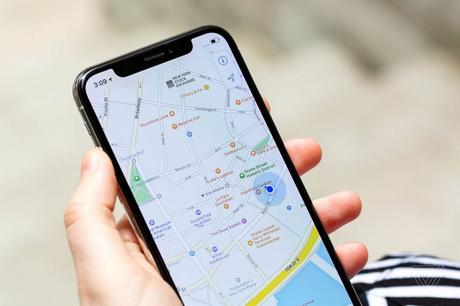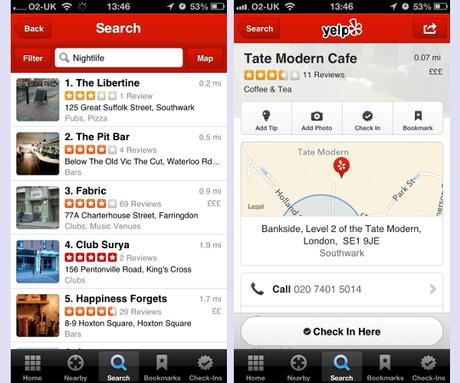Optimising your SEO strategy and website for multiple locations isn’t, on the whole, that easy. As with any strategy Google is always changing the goal posts you need to address and you will often require the help of developers for complete optimisation.
This multi-location SEO guide is designed to be your one-stop guide to help you understand where to start and what could be missing from your strategy (as a minimum).
What is Multi-Location SEO?
Multiple Site or Multi Location SEO is search engine optimisation for businesses with multiple locations of brick ‘n’ mortar stores / offices which want to appear well in search.
Search engines, like Google, want to customise search to users. To this end when a user searches for a particular store or brand they are today likely to find a stack of local stores for that brand appear in search results – this is known as the “local pack”. This is matched off only the brand names.
It’s also more relevant for the growing Voice Search trend where users are searching using terms such as “_____ near me” and potentially being given a map again or directions to the local store.

Multi-location SEO works for any number of locations from 5 to 5000 and even 50,000 if done correctly. Franchises such as McDonalds use it too, so don’t get hung up on whether these strategies can work for you.
1 – Site Structure
As with any website, site structure and more particularly URL structure is one of the keys to search success. It can also be one of the first points to failure.
The first rule here is that whilst you can have an index of all your locations on a single page you should never simply have a single page of all your locations acting as your multi-location page. User’s will find it complicated, annoying and frustrating – but search engines will just wonder what the hell is going on.
The best solution all round is to have each location on it’s own page, or rather set of pages where relevant. Here is an example of how this works:
your-store.com/locations < this is your index of stores
your-store.com/locations/manchester < an individual store page
your-store.com/locations/manchester/directions < store directions
your-store.com/locations/manchester/offers < specific location offers
As you see this structure offers a clean and simple approach, it would be easy for users to remember and easy to replicate by store.
If you are multi-national, or multi-state, as well as multi-location then perhaps skipping a location index with a complete index and simply having a search would be of more use to users. However I would suggest a url setup as follows:
intl-store.com/country/state/ < you could still have a state index if needed
intl-store.com/country/state/location < individual location page
Importantly, do not create a separate domain or sub-domain for each location in your business. It many cases a country based approach is ideal, however beyond this a centralised approach is the optimal SEO strategy. With decentralisation of locations websites comes reduced “link juice” and Domain Authority, this should always be cemented centrally to the main brand website to ensure growth and sustained authority.
2 – Location Page Structure
Read this section carefully this is where all the real secrets to success are for on-site success with multi-location seo success!
With each individual location page, every location should have the same specific information and in the same format. This is to say the same pieces of information appear on each page but it should be unique for each location.
Those pieces of information are these (though may not be limited to):
- The complete Location name, address and phone number (NAP). In the correct format as per Google requirements!
- Location-specific content, and lots of it! This means testimonials, access information, photos, opening times and offers.
- Complete descriptions of how to get to your business using key transport infrastructure (whether that is buses, trains or motorways).
- Specific on-page content (text) about the location, even if this is only a few sentences make the content unique to the page.
- Unique location focused Meta Tags (title and description), this is what appears in search and whilst has little value for rankings it is what users see and hear (voice search).
- Did I mention use amazing images? (and maybe video too!)
With all the above you will have a really keen advantage over your competitors in 95% of cases. Most will just roll out the same content to every page, just changing opening times and thats about it – so always go the extra mile for your users.
Here is where you can go the extra mile for your users.
Just like search engines, user appreciates the information, but they find it hard to find so formatting is key – put information where they can find it easily, use clear heading (use styling and not h1 tags all over the shop – remember you can only have one h1 tag on a page).

Next up, remember that voice search is a growing trend and you need to write naturally. No one talks without taking a breath. So, keep your information simple and remember you want search engines to be able to strip it out easily.
This brings us neatly to a BIG TIP, implement microformats! I have bleated on about microformats and structured data for years and exploited it’s worth for clients. Today we are seeing with voice search exactly how that works for everyone overall. Using Schema.org you will be able to implement LocalBusiness Structured Data information (among other should you decide) and make it much easier for search engines to find the relevant information on your location pages, data that can be served immediately with search to users – potentially increasing your rankability and voice searchability.
Handy SEO Tips
All the above may have you itching to get started, but before you do a few words of caution.
1) Don’t create a ton of location pages for areas you don’t operate in, as a rule of thumb only create a page if you have an office locally and can put an address to it.
2) Don’t create several pages for one location and try to keyword stuff them (eg /seo-manchester /seo-in-manchester and /best-seo-manchester … just create one page for each location and let the content on the page do the work, several pages will simply decrease any ranking juice.
3 – Optimise Google My Business & Bing Places

It is important that across the two big search engines you own your locations and brand, the way to do this is claiming your locations using Google My Business and Bing Places.
These operate in much the same fashion, and importantly have feeds across other sites and into the vast mobile world. This means that almost every person carries this search within their pockets, searching for your brand or products could mean finding your local store … or your competitors. Caring for your locations on these platforms could mean the difference between a sale or not.
Here are my top tips to optimise these platforms.
- Ensure all information is accurate, spelt correctly and as comprehensive as possible. (fill every box, category and attribute if you can). Ensure your name, address, phone number (NAP) is in the correct Google/Bing format.
- Link directly to your local page.
- Upload photos regularly of the store, upload videos to where possible.
- Ask your customers to review you on GMB. (this is shown to increase the incidence of GMB showing in search).
- Turn on Messaging through GMB, allowing customers to talk to you via GMB.
- Don’t neglect your GMB/BP presence ever, update them regularly (if there is a lot, do them on a cycle).
Handy SEO Tip
Always make sure your local business is verified, if you notice it ever ‘drops off’ claim it again. It is rare to see a non-verified business appear directly in search of a non-brand search, verification will increase your chances of appearing in local search.
If you want to know more about optimising Google My Business, check out Neil Patels article on the subject.
4 – Build Local Citations
Local Citations are in effect the links/citations from large scale directory-type websites offering guides to areas or the such. A good example of this type of website is Yelp or TripAdvisor – there are also industry-specific directories which can provide citations, as can local news publications.

Building localised citations with links towards the Location Pages, not the main website page, is a key way of indicating to search engines this is the main page for this town, city or region.
Often you will see citation pages appear directly in search for certain types of search, for example “plumbers in manchester”, “photographers in manchester” or “local restaurants” – these are all likely to turn up some type of citation website. Each listing a business with a possible link back to that businesses website.
As with GMB and BP (previously mentioned), you should optimise citations using the following steps:
- Ensure all information is accurate, spelt correctly and as comprehensive as possible. (fill every box, category and attribute if you can).
- Link only to your location page.
- Upload photos regularly of the store, upload videos to where possible.
- Ask your customers to review you if appropriate on the platform (mainly for Yelp type platforms)
- Update your profiles on a regular basis, this is likely to increase your rankings within the database.
5 – Build Localised Content
On-Site – This step is more common for single location SEO than for multi-location SEO. However, you will always want to produce specific content which meets the user’s expectations and this will always be local to a page – in particular, if they land there or navigation quickly to a page.
With this in mind, each location page should be highly localised. Offers should be specific and any blogs shown should be applicable to that location. My own preference is to also have specific blogs written for each location if possible or each region, making content even more specific and improving the local seo of these pages further – as well as the user experience.
Off-site / Link building – As with any website, the links your website can attain can help to improve your rankings. This is no different with local SEO.
Indeed, it is often much clearer to see the results of a great link building strategy within a localised niche than it is non-localised or link building on more generic terms. This is because local search often reacts faster with ranking changes and there is less competitions often (though this isn’t always the case), this means being local and building local authority links can quickly improve your local rankings.
The best places as always are industry website, blogs and longterm influencers, but other great places to look at for links include news publications and local events. Ensuring links remain local and industry-led is the key to success. Don’t forget the links must always lead to the location page, this should then have a positive effect on your rankings.
Conclusion
Multi-location SEO isn’t an easy game, it isn’t a quick game and it all starts by getting your website in order.
Once you’ve done that move on to your externals.
But always remember user experience is key, keep things consistent and if you’ve a lot of locations this will be a long road but it will be worth it.

